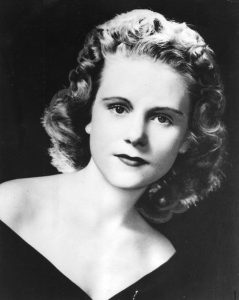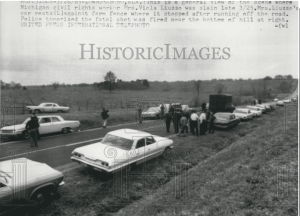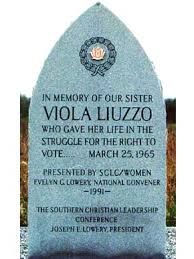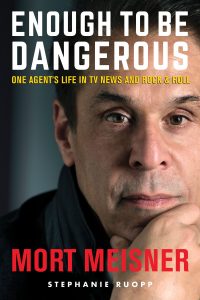In our previous blog post, we talked about some of the big stories in Mort Meisner’s career that boosted ratings.
But some of the other big stories in his career were those that truly moved him. They were the stories that made him want to get involved on a deeper level.
And at the end of the day – or the newscast, as it were – they were the stories that made a difference.
Some of the Big Stories That Truly Mattered
Spend any time with Mort and you’ll hear a wealth of fascinating stories about his years in the music and news industries. But the following stories are among the ones of which he is most proud. They are the stories that enacted change.
Viola Liuzzo

Murdered Detroit Civil Rights Worker, Viola Liuzzo
In 1965, when Mort was just 12 years old, Viola Liuzzo, a civil rights activist from Michigan and mother of five, was murdered along with two black men while on a freedom fighting mission in Selma, Alabama. Her murderers were members of the Ku Klux Klan.
There was no investigation, however. From Mort’s memoir, Enough to Be Dangerous:
- Edgar Hoover was the head of the FBI at the time and served only to besmirch Liuzzo’s image. He was determined to portray her as a whore who just wanted to have sex with black men. Her case was sealed for years until her family sued the FBI in the late 1970s. At Channel 7, we did news stories to try to force those files unsealed. And finally, the family won the case to open them.

Viola Liuzzo Crime Scene – Image courtesy of Historic Images.
To this day, Mort continues to have relationships with Viola’s adult children. Her murder put a tremendous strain on the family though. While her son, Tony Jr., delivers powerful lectures on civil

Viola Liuzzo Memorial Stone
rights, some of his siblings developed drug and alcohol problems. And their father died a broken-down alcoholic.
The Palm Leaf Murders
Mort had been just two years in the news business in 1979 when there was a series of prostitutes being kidnapped, raped and murdered. The assailant always left behind palm leaves on the bodies of the victims as his mark.
The story didn’t get much coverage for two reasons. One, the victims were prostitutes and therefore considered second-class citizens. And two, the Republican National Convention was coming to Detroit the following year and Mayor Coleman Young wanted to keep the story under wraps.
It was horrifying.
Then one day, a woman called the assignment desk at WXYZ and reported that she’d been a victim of the assailant. Mort had taken the call.
On my urging, she went to the police and met with the head of homicide, Robert Hislop. The whole venture was pointless, though. He sent her away because neither he, nor the rest of the police, believed her.
So I went to Kathryn Kiefer, a female reporter who worked for me and whom I highly respected. I told her what was happening. We decided to collaborate on a series of stories about these prostitutes who were being raped and murdered.
Kathryn invited the woman to tell her story on the air. She told her near death story, how she’d faked her death, and how when she went to police, they turned her away. Of course, this didn’t go over too well with the police or the mayor’s office.
Of course, Gerald Hale of the Detroit Police didn’t take too kindly to this. He put out a notification that Kathryn and Mort were engaged in deceptive practices. They were sure they would get canned.
They didn’t though. The GM put out a news release that supported them while attacking the Detroit Police Department. Hislop was forced to retire a short time later.
It would be quite a few years before the man, Carl Watts, was caught and dubbed “The Sunday Morning Slasher.”
When Brother Kills Brother
Sick and tired of seeing young black men and women shot to death – often by members of their own community in their community – Mort decided to do a story called, “When Brother Kills Brother.”
He called in one of his top reporters and told him his idea. He wanted the reporter to go into the neighborhood and knock on the door of every small, medium, and large undertaker.
Mort hoped that the reporter would be able to find an undertaker – preferably an older man or woman – who would be willing to wear a wireless mic and be interviewed while embalming the body of someone under 16.
The reporter found the story, but no one who was willing to wear the mic. And then one day, he did. As Mort recalls:
This was a man who was no stranger to embalming. It was a routine part of his work. But to hear his voice shake, shiver, and crack while embalming a young black man was powerful and emotional. And it was precisely what I wanted to get. The result was an award-winning piece that was so moving that it brought the story home. It didn’t change things in the neighborhoods. But it informed and shined a spotlight where it had not been shined before.
In the late 1980s, Time magazine ripped off the story. They even used the headline When Brother Kills Brother. Mort saw it as homage though. To him, the crucial part was that they were able to shed light on a very dark situation.
They made a difference.
Looking for More Stories That Matter?
Enough to Be Dangerous is chock full of them. So get an eyeful of the big stories and triumphs, as well as the hard times and defeats that have woven the fabric of Mort’s life.
The book will be available October 1st from Two Sisters Writing and Publishing. But you can pre-order your autographed copy today by clicking here.
And be sure to subscribe to our blog to stay in the know about the launch party and other events surrounding this unforgettable memoir.

